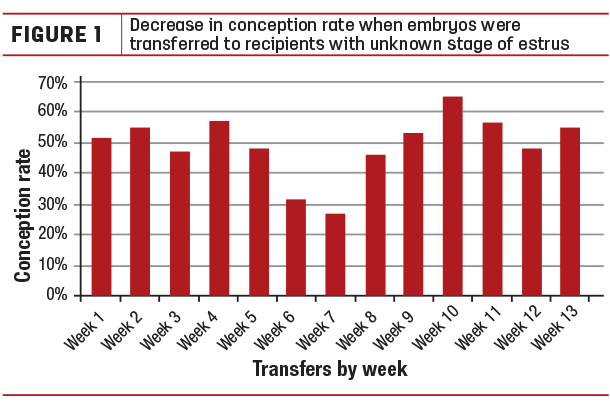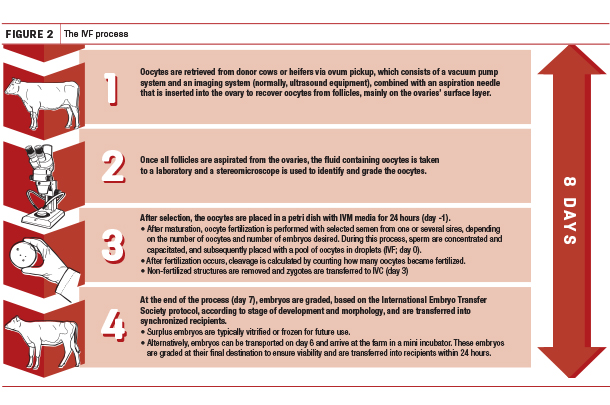In vitro fertilization (IVF) – it isn’t just for registered cattle breeders anymore. A useful biotechnology tool, IVF can be incorporated into any dairy system. However, the dairy’s management team must be committed to the long-term investment, selection criteria and IVF protocols.
Interestingly, some Brazilian dairies do not use artificial insemination (A.I.), but use IVF-embryo transfer exclusively. Is this a strategy that should be considered in the U.S.? With a contracting agricultural land base, due to increasing human population, urbanization and economic development, new technologies will allow farmers to produce more (output) with less (input).
Like A.I., I predict the dairy industry will perfect the application of IVF and ultimately increase milk and meat production – in an even more sustainable manner.
For a little background, IVF is more than a “petri dish” in a laboratory. The process involves three steps: in vitro maturation (IVM), IVF and in vitro culture (IVC). These procedures (see Figure 2) combined define the complete process of in vitro embryo production. It takes about eight days to produce an embryo under in vitro conditions.
Click here or on the image above to view it at full size in a new window.
Accelerated gains
Why should dairy producers consider IVF? This technology yields accelerated genetic gain by using better donors, based on genomic testing (also known as genotyping). IVF lends itself to implementing a strategic reproduction management program, such as crossbreeding (F1) and breed switching. Also, it provides the possibility of using gender-sorted semen to produce female embryos on a large scale.
Additionally, IVF can be used to retrieve embryos from females that do not respond to superovulation treatment, salvage genetic potential from terminally ill heifers or cows and produce embryos from slaughterhouse ovaries.
If heat stress impairs your herd’s reproductive performance, you may have another reason to consider an embryo program. Embryos are more tolerant to high body temperatures (due to heat stress) than oocytes.
Due to decreased progesterone, compounded by heat stress, consider IVF to avoid issues with poor fertilization, degenerated or poor-quality embryos and early embryonic death. Additionally, embryo therapy reduces twin pregnancies and transition challenges, such as retained placenta and metritis.
Room for improvement
Unfortunately, commercial IVF is still somewhat inefficient – rarely achieving more than 40 percent viable embryos out of those initially placed into maturation media.
Despite some pitfalls, such as cost per pregnancy/live birth, higher embryonic losses, higher abortion rates, lower offspring viability and necessary special care, IVF is currently the most efficient animal multiplication tool for bovine genetic improvement.
To increase its effectiveness, IVF use should be based on genomic testing or phenotypic selection of the best herd donor females, combined with using high-genetic-merit bulls to obtain large numbers of top offspring and greater genetic gains per generation.
Selection criteria
When evaluating potential donors, consider vaccination, biosecurity, nutrition and transition period management. Use a proper vaccination protocol and test donors for infectious diseases, such as bovine leukosis, bovine viral diarrhea and Johne’s disease.
A comprehensive ultrasound can be performed to evaluate the reproductive tract and predict oocyte production. Beyond health, use phenotypic or genotypic data to select IVF donors.
From a phenotypic perspective, consider general conformation, height, mature bodyweight, udder type, pelvic size and shape, milk production, and butterfat and protein content.
Use these factors to calculate group indexes that rank the cows or their calves within the herd, or more specifically within a contemporary group, for many traits. A group index for a trait is ranked as a percentage above or below the average in its contemporary group.
When considering genomic test results, Predicted Transmitting Ability (PTA) is very helpful in making dairy cattle breeding decisions. Some well-known selection indexes, such as Net Merit$, have health (Somatic Cell Score) and fertility traits like Daughter Pregnancy Rate (DPR) included in them.
Genomic selection has the highest value when selecting for traits that are difficult or expensive to measure (e.g., health and fertility), occur later in life or when the animal has no or few offspring. Udder health, hoof health and postpartum disease traits (metritis, retained placenta, displaced abomasum and ketosis) can be selected.
Genomic selection allows culling and mating to be tailored by aligning a farm’s breeding objectives with indexes matching the dairy manager’s herd vision.
Combine IVF, sexed semen
To capitalize on the genetic strength of an IVF program, use it with gender-sorted semen. With these technologies, dairy producers can quickly achieve the desired number of offspring with the genetic characteristics selected and create financial revenue by selling surplus animals.
Just like donors, develop a strategy to select embryo recipients. Select recipients based on size, calving ease, type of embryo to be transplanted and genomic testing. Again, like donors, select healthy recipients that experienced a well-designed vaccination protocol. Generally, genetically inferior animals “host” embryos.
Another strategy is to select recipients based on DPR. A University of Florida study showed a positive correlation between Heifer Conception Rate and DPR. Place embryos produced from superior TPI donors into recipients with the highest DPR.
The preference for using heifers as recipients is due to their greater fertility compared with lactating cows. The variability in cow conception from Sequoia Veterinary Services’ IVF lab, Tulare, California, is 28 to 48 percent. In heifers, this number ranges from 40 to 58 percent.
Synchronize embryo stage, recipients
The synchrony between embryo stage and recipients is crucial. Transferring an embryo to an asynchronous uterus can be costly (Figure 1).
 Conception decreased when embryos were transferred to recipients with an unknown stage of estrus (weeks six and seven). Heats were not monitored due to labor issues.
Conception decreased when embryos were transferred to recipients with an unknown stage of estrus (weeks six and seven). Heats were not monitored due to labor issues.
With the improvements in IVF embryo freezing, the ability of using embryos on a large scale becomes more realistic. Herd managers should focus on managing donors and recipients, and leave the embryo handling to IVF experts.
Despite some challenges, IVF technologies will greatly improve. Several commercial herds have successfully implemented this biotechnology. Cattle prices, efficiency, genetics, genomics and milk prices will drive the adoption of IVF. Producers can become more efficient, competitive and perhaps position themselves with more favorable profit margins with the use of IVF. ![]()
This article is contributed on behalf of the Dairy Cattle Reproduction Council (DCRC).

-
Cesar D. Narciso
- Veterinary Practitioner
- Sequoia Veterinary Services Inc.
- Tulare, California
- Email Cesar D. Narciso







